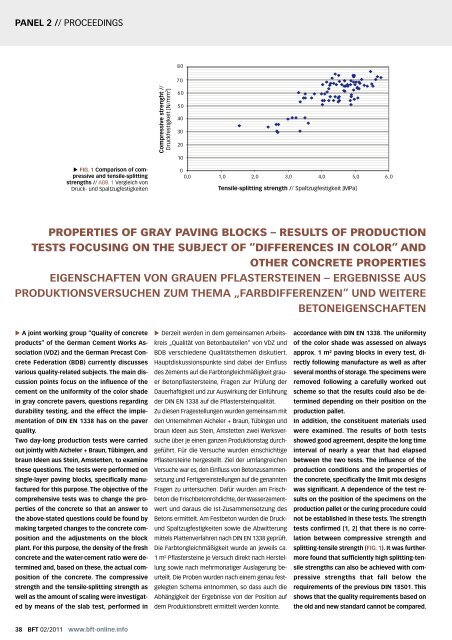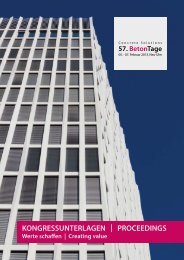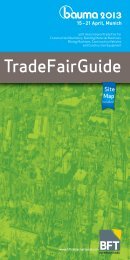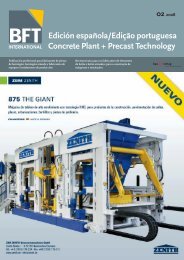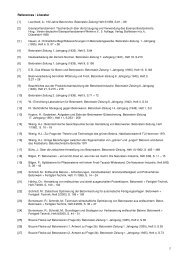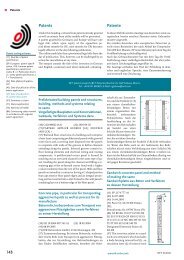Tagungsband - BFT International
Tagungsband - BFT International
Tagungsband - BFT International
Sie wollen auch ein ePaper? Erhöhen Sie die Reichweite Ihrer Titel.
YUMPU macht aus Druck-PDFs automatisch weboptimierte ePaper, die Google liebt.
PANEL 2 // PROCEEDINGS<br />
� A joint working group “Quality of concrete<br />
products” of the German Cement Works As-<br />
sociation (VDZ) and the German Precast Con-<br />
crete Federation (BDB) currently discusses<br />
various quality-related subjects. The main dis-<br />
cussion points focus on the influence of the<br />
cement on the uniformity of the color shade<br />
in gray concrete pavers, questions regarding<br />
durability testing, and the effect the imple-<br />
mentation of DIN EN 1338 has on the paver<br />
quality.<br />
� FIG. 1 Comparison of compressive<br />
and tensile-splitting<br />
strengths // ABB. 1 Vergleich von<br />
Druck- und Spaltzugfestigkeiten<br />
Two day-long production tests were carried<br />
out jointly with Aicheler + Braun, Tübingen, and<br />
braun Ideen aus Stein, Amstetten, to examine<br />
these questions. The tests were performed on<br />
single-layer paving blocks, specifically manu-<br />
factured for this purpose. The objective of the<br />
comprehensive tests was to change the pro-<br />
perties of the concrete so that an answer to<br />
the above-stated questions could be found by<br />
making targeted changes to the concrete com-<br />
position and the adjustments on the block<br />
plant. For this purpose, the density of the fresh<br />
concrete and the water-cement ratio were de-<br />
termined and, based on these, the actual com-<br />
position of the concrete. The compressive<br />
strength and the tensile-splitting strength as<br />
well as the amount of scaling were investigat-<br />
ed by means of the slab test, performed in<br />
38 <strong>BFT</strong> 02/2011 www.bft-online.info<br />
Compressive strenght //<br />
Druckfestigkeit [N/mm2 ]<br />
80<br />
70<br />
60<br />
50<br />
40<br />
30<br />
20<br />
10<br />
0<br />
0,0 1,0 2,0 3,0 4,0 5,0 6,0<br />
PROPERTIES OF GRAY PAVING BLOCKS – RESULTS OF PRODUCTION<br />
TESTS FOCUSING ON THE SUBJECT OF “DIFFERENCES IN COLOR” AND<br />
OTHER CONCRETE PROPERTIES<br />
EIGENSCHAFTEN VON GRAUEN PFLASTERSTEINEN – ERGEBNISSE AUS<br />
PRODUKTIONSVERSUCHEN ZUM THEMA „FARBDIFFERENZEN“ UND WEITERE<br />
BETONEIGENSCHAFTEN<br />
� Derzeit werden in dem gemeinsamen Arbeits-<br />
kreis „Qualität von Betonbauteilen“ von VDZ und<br />
BDB verschiedene Qualitätsthemen diskutiert.<br />
Hauptdiskussionspunkte sind dabei der Einfluss<br />
des Zements auf die Farbtongleichmäßigkeit grau-<br />
er Betonpflastersteine, Fragen zur Prüfung der<br />
Dauerhaftigkeit und zur Auswirkung der Einführung<br />
der DIN EN 1338 auf die Pflastersteinqualität.<br />
Zu diesen Fragestellungen wurden gemeinsam mit<br />
den Unternehmen Aicheler + Braun, Tübingen und<br />
braun Ideen aus Stein, Amstetten zwei Werksver-<br />
suche über je einen ganzen Produktionstag durch-<br />
geführt. Für die Versuche wurden einschichtige<br />
Pflastersteine hergestellt. Ziel der umfangreichen<br />
Versuche war es, den Einfluss von Betonzusammen-<br />
setzung und Fertigereinstellungen auf die genannten<br />
Fragen zu untersuchen. Dafür wurden am Frisch-<br />
beton die Frischbetonrohdichte, der Wasserzement-<br />
wert und daraus die Ist-Zusammensetzung des<br />
Betons ermittelt. Am Festbeton wurden die Druck-<br />
und Spaltzugfestigkeiten sowie die Abwitterung<br />
mittels Plattenverfahren nach DIN EN 1338 geprüft.<br />
Die Farbtongleichmäßigkeit wurde an jeweils ca.<br />
1 m² Pflastersteine je Versuch direkt nach Herstel-<br />
lung sowie nach mehrmonatiger Auslagerung be-<br />
urteilt. Die Proben wurden nach einem genau fest-<br />
gelegten Schema entnommen, so dass auch die<br />
Abhängigkeit der Ergebnisse von der Position auf<br />
dem Produktionsbrett ermittelt werden konnte.<br />
Tensile-splitting strength // Spaltzugfestigkeit [MPa]<br />
accordance with DIN EN 1338. The uniformity<br />
of the color shade was assessed on always<br />
approx. 1 m² paving blocks in every test, di-<br />
rectly following manufacture as well as after<br />
several months of storage. The specimens were<br />
removed following a carefully worked out<br />
scheme so that the results could also be de-<br />
termined depending on their position on the<br />
production pallet.<br />
In addition, the constituent materials used<br />
were examined. The results of both tests<br />
showed good agreement, despite the long time<br />
interval of nearly a year that had elapsed<br />
between the two tests. The influence of the<br />
production conditions and the properties of<br />
the concrete, specifically the limit mix designs<br />
was significant. A dependence of the test re-<br />
sults on the position of the specimens on the<br />
production pallet or the curing procedure could<br />
not be established in these tests. The strength<br />
tests confirmed [1, 2] that there is no corre-<br />
lation between compressive strength and<br />
splitting-tensile strength (FIG. 1). It was further-<br />
more found that sufficiently high splitting-ten-<br />
sile strengths can also be achieved with com-<br />
pressive strengths that fall below the<br />
requirements of the previous DIN 18501. This<br />
shows that the quality requirements based on<br />
the old and new standard cannot be compared.


